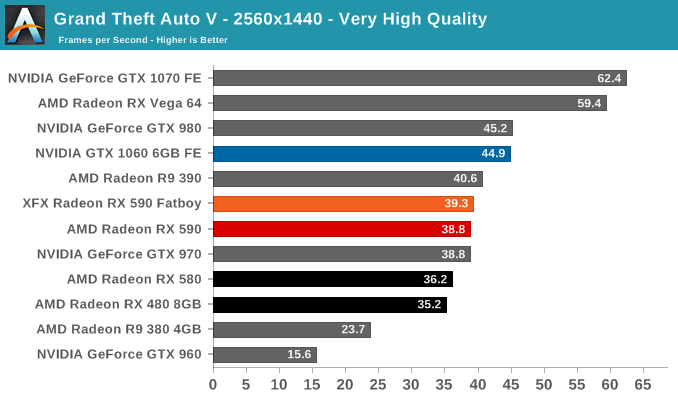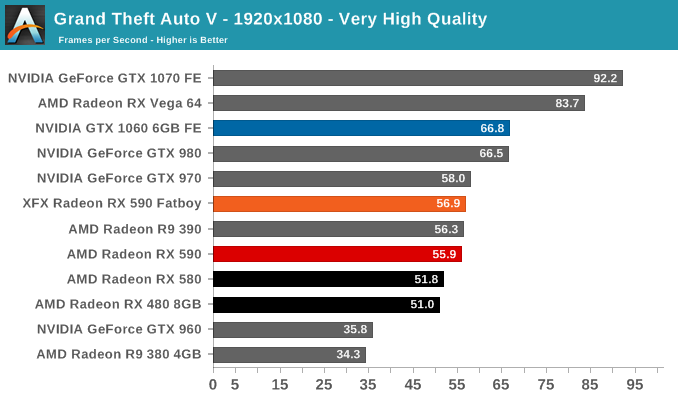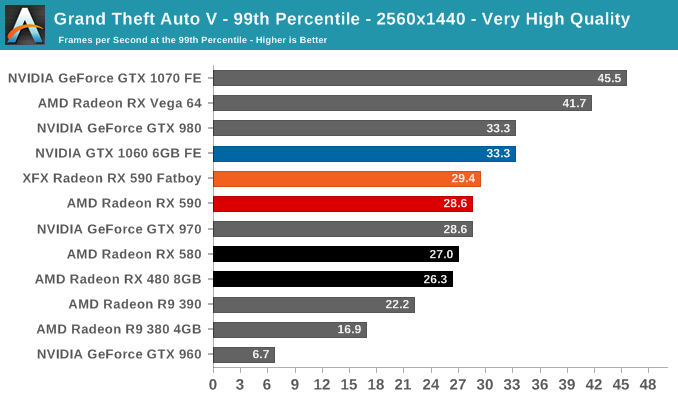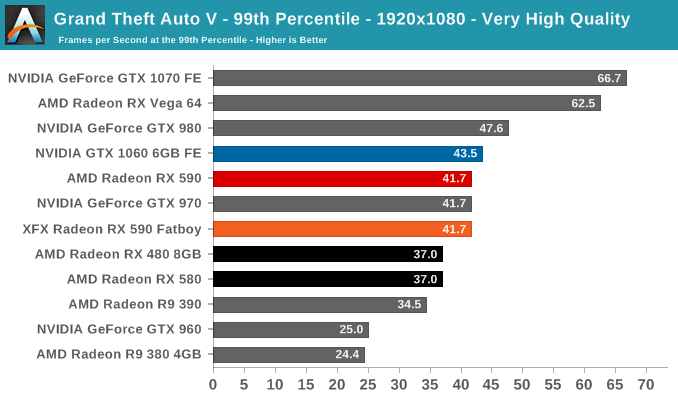The AMD Radeon RX 590 Review, feat. XFX & PowerColor: Polaris Returns (Again)
by Nate Oh on November 15, 2018 9:00 AM ESTGrand Theft Auto V (DX11)
Now a truly venerable title, GTA V is a veteran of past game suites that is still graphically demanding as they come. As an older DX11 title, it provides a glimpse into the graphically intensive games of yesteryear that don't incorporate the latest features. Originally released for consoles in 2013, the PC port came with a slew of graphical enhancements and options. Just as importantly, GTA V includes a rather intensive and informative built-in benchmark, somewhat uncommon in open-world games.
The settings are identical to its previous appearances, which are custom as GTA V does not have presets. To recap, a "Very High" quality is used, where all primary graphics settings turned up to their highest setting, except grass, which is at its own very high setting. Meanwhile 4x MSAA is enabled for direct views and reflections. This setting also involves turning on some of the advanced rendering features - the game's long shadows, high resolution shadows, and high definition flight streaming - but not increasing the view distance any further.


The ever-popular GTA V has proven itself a very demanding game even on the latest hardware, despite its age. Overall NVIDIA cards usually fare much better on it, and the GTX 1060 6GB is no exception. Polaris' best efforts across generations have narrowed the gap but isn't enough to bring it into contention against the GTX 1060 6GB. The 2GB framebuffer of the GTX 960 isn't sufficient for 1440p and falls behind the R9 380 4GB with completely unplayable performance, though at 1440p both the R9 380 4GB and the GTX 960 lack the raw horsepower to drive gameplay at that resolution anyway.













136 Comments
View All Comments
mapesdhs - Thursday, November 15, 2018 - link
Very true, though I suppose wrt the 590 this kinda works against AMD a bit since pretty much all the optimisation that the 590 could ever have benefited from is already there.sasquatch85 - Thursday, November 15, 2018 - link
I think there are quite a few owners of pitcairn-based cards that would object page 2. That GCN1 architecture made it from 78xx in 2011 up through the R7 370 in 2015. Polaris always seemed to be aiming to replace that core in the lineup and definitely fit right in at the same price levels. However, I never thought that actual performance difference was enough to justify a purchase until this 590, but that comes at a much higher price. I think I can still hold out with my 7870 for the next mid-range architecture on 7nm before finally scratching the upgrade itch.edzieba - Thursday, November 15, 2018 - link
"This is enabled by being fabbed on 12nm and being afforded higher TBPs"Traditional Buttered Pixels? Total Bungholiomark Points?
JoeyJoJo123 - Thursday, November 15, 2018 - link
Total Board Power? Because the GPU is more efficient at a 12nm process, they can spend that extra headroom overclocking the chip to run faster. That was the point of the statement.edzieba - Thursday, November 15, 2018 - link
I think it was a typo of TDP, I was just having some fun.PeachNCream - Thursday, November 15, 2018 - link
TBP is not a typo. I think it's Typical Board Power or, as Joey said, Total Board Power. AMD was swinging that term a year or three ago (not really sure when they started that) for some marketing-driven reason and, in the absence of better power and heat numbers to refer to, tech journalists are forced to resort to it in the articles they write.eastcoast_pete - Thursday, November 15, 2018 - link
@Nate: thanks for the review. Now, I know that this card (and the 1060 from Nvidia) are targeted for gaming at 1080p or 1440p with high or ultra settings, but I would have liked to see how this card does in UHD. If you have any data, please share them - Thanks! Now, I don't expect the Rx 590 or 580 to provide playable frame rates for all games in UHD, but I like to now how close these mid-rangers come to the higher-end cards when they really stressed (UHD with some goodies turned on). Plus, the extra 2 Gb of VRAM vs. the 1060 might make it possible to handle games the 6 Gb 1060 can not. Any information? Thanks!KateH - Thursday, November 15, 2018 - link
A 40CU config (as was initially rumored) would have been much more interesting- at >1500mhz boost such a card would be nipping at the heels of the GTX 1070 and at around $320 it would have been a great deal even if the TBP hit 250W but this is kind of mediocre, even if it's a bit faster than the 1060. If the price undercut the 1060 it would be a good deal but at higher price AND power? Not worth it unless Freesync is important to you. I heard some variants could clock up to 1680mhz- I'd be curious to see how that performs.Arbie - Thursday, November 15, 2018 - link
Thanks for the good article, and the inclusion of Ashes in the comparison charts.boozed - Thursday, November 15, 2018 - link
"Meh"